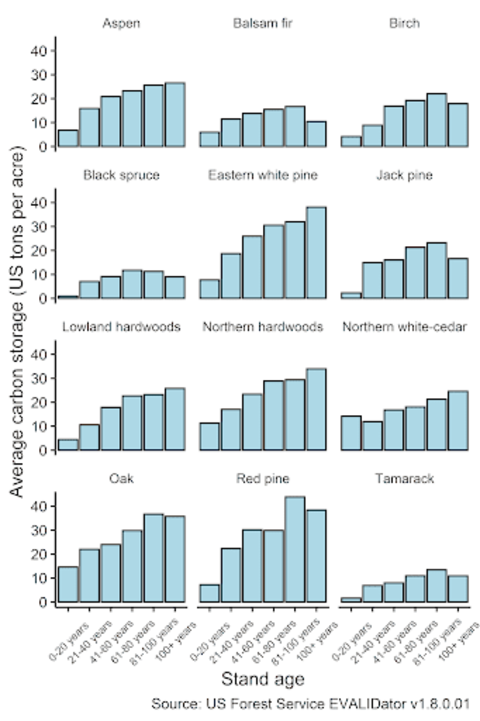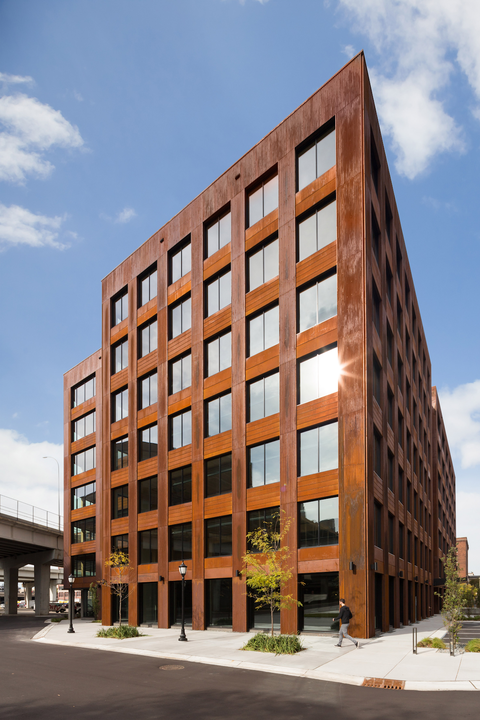Quick facts
- Trees and forests sequester carbon dioxide and other greenhouse gases from the atmosphere.
- Approximately half of a tree’s dry weight is carbon.
- Woodlands in Minnesota store on average 75 U.S. tons of carbon per acre.
- Woodland owners can manage their land for carbon storage, carbon sequestration or both.
- Forest carbon offset programs typically used by landowners with large acreages provide payment to landowners for the carbon benefits their woodlands provide.
One of the many benefits that trees provide is removing carbon dioxide from the air. Carbon dioxide is the leading source of greenhouse gas emissions in the United States.
In trees and woodlands, carbon is measured by how much is stored and sequestered. Carbon storage refers to the current amount of carbon in a tree or woodland. Carbon sequestration refers to the process by which trees and other plants use carbon dioxide and photosynthesis to store carbon as plant biomass.
Healthy trees and woodlands increase carbon storage and avoid greenhouse gas emissions. In the United States, trees and forests annually sequester approximately 11% of all greenhouse gas emissions. Understanding how trees and woodlands use carbon leads to a better knowledge of their importance in meeting future global challenges related to climate change.
How much carbon is in a tree?
Approximately half of a tree’s dry weight is carbon. The amount of carbon that is stored in a tree depends on its size, age and species. Carbon is typically measured in pounds or kilograms. A single tree can sequester as much as 10 pounds of carbon dioxide each year.
To determine how much carbon is in a tree, foresters commonly measure a tree’s diameter at breast height (4.5 feet above the ground). For the same diameter tree, maple, oak, hickory and beech trees store the most carbon compared to other species.
Trees are not the only component where carbon is stored in woodlands. Woodlands store carbon in five different pools:
- Live trees, aboveground: Includes trees, shrubs and other vegetation.
- Live trees, belowground: Includes coarse and fine roots.
- Dead wood: Includes standing dead trees and downed dead wood.
- Litter: Includes leaves and other small woody material.
- Soil: Includes mineral and organic soil with dead and decaying plant material and insects.
How much carbon is in a woodland?
The amount of carbon in a woodland is constantly changing as new trees grow and old trees die. Generally, the amount of carbon stored in a woodland increases as it ages. Carbon in a woodland is typically measured in U.S. tons (where 1 U.S. ton = 2,000 pounds) or metric tonnes (also known as megagrams).
In Minnesota, woodlands average 75 U.S. tons of carbon per acre across all five carbon pools (or 169 metric tonnes per hectare). Most of the carbon found in Minnesota woodlands is distributed in mineral soil and aboveground live trees.
Disturbances will affect how much carbon is stored in a woodland depending on its type and severity. Common disturbances in Minnesota include insects, diseases, windstorms and fires.
To compare how different disturbances impact woodlands, consider two events: a wildfire and an insect outbreak. If a wildfire burns all trees in an area, there is an immediate release of all carbon stored in trees to the atmosphere. This would be an immediate loss of carbon. In contrast, if an insect defoliated all trees in an area and it led to tree mortality over a few years, many trees would remain standing dead and eventually fall to the forest floor. As these dead trees decompose, they will slowly release carbon to the atmosphere typically over the span of several decades or more.
Despite major forest disturbances, carbon storage has increased over the last several decades in Minnesota. Total forest ecosystem carbon stocks in Minnesota have increased from 1,243 million U.S. tons in 1990 to 1,337 million U.S. tons in 2019.
Managing woodlands for carbon
Every woodland is unique in terms of its age, species composition, soil type and history. How you manage a woodland will influence how much carbon it stores and sequesters.
To maximize carbon storage, manage for old woodlands (e.g., greater than 50 years old). Through this approach, manage for large-sized trees (greater than 10 inches in diameter) that are of high quality. If timber harvesting is appropriate for this woodland, harvested wood can be marketed as sawtimber and veneer. Wood can be made into long-lived wood products such as lumber, construction materials, cabin logs, utility poles and other durable wood products that continue to store carbon into the future.
In older woodlands, as trees die they will add to carbon pools such as dead wood and litter. The growth of individual trees is slower in older woodlands, but carbon storage is greater across the woodland.
Each tree species stores a different amount of carbon due to its wood density. As an example, 90-year old oak forests in Minnesota store on average 44 tons of carbon per acre. In contrast, carbon in 90-year old aspen forests in Minnesota store on average 26 tons of carbon per acre.
To maximize carbon sequestration rates, manage for young woodlands (e.g., less than 50 years old). Through this approach, you can manage for small to medium-sized trees (4 to 10 inches in diameter). If timber harvesting is appropriate for this woodland, harvested wood can be made into shorter-lived wood products such as pulpwood and paper.
In young woodlands, competition among trees is high as they compete for available resources and growing space. Dominant trees will outcompete weaker ones, and this competition leads to high carbon sequestration rates in young woodlands.
Carbon sequestration decreases in woodlands as they age. The following show carbon sequestration rates by ages, represented by total carbon in above and belowground trees across all forest types in Minnesota:
- 10-year-old forests: 0.60 tons of carbon per acre per year
- 50-year-old forests: 0.20 tons of carbon per acre per year
- 100-year-old forests: 0.15 tons of carbon per acre per year
To manage for both carbon storage and sequestration rates, manage trees with a diversity of ages in your woodland. In this approach, young trees will continue to sequester carbon at high rates, while old trees will store large amounts of carbon.
To continue to store and sequester carbon at high rates, implement woodland management strategies that promote a variety of tree ages. These systems, termed uneven-aged regeneration systems, promote a variety of tree species, ages and sizes within a woodland. Uneven-aged treatments such as single-tree and group selection harvests will promote the establishment of new trees and mimic small-scale natural disturbances such as wind events and insect defoliation.
Managing for carbon in your woodland may be only one component of your goals as a landowner. Work with a forester or natural resource professional to create or update a woodland stewardship plan for your property.
Carbon in wood products
If wood is harvested from a sustainably managed forest, it is a renewable resource. Carbon can be stored in wood products in a variety of forms that can be short-lived (such as paper) or long-lived (such as utility poles or wood-based construction materials).
Harvested wood products in use and solid waste disposal sites represent 4.5% of the total amount of carbon found in the U.S. Wood-based bioenergy generally has a smaller carbon footprint compared to fossil fuels and other renewable energy forms.
The benefits of wood products include carbon storage and lower emissions than fossil fuel-intensive materials such as steel and concrete. Wood is an environmentally friendly building material.
As an example, mass timber buildings (large multi-story buildings made with wood) are increasingly being built across the world. Mass timber buildings are lighter than other traditional buildings commonly designed with steel, are fire-resistant, and can be built more quickly compared to a traditional concrete and steel building. As a result, building codes are being changed or altered that support the construction of mass timber buildings.
Carbon offset markets
A number of forest carbon offset markets have been established that seek to capitalize on the value that trees and forests provide in storing carbon and removing carbon dioxide from the atmosphere. In these markets, corporations and individuals pay for carbon dioxide emissions to offset their own emissions. Landowners are paid for the carbon storage and sequestration their trees provide.
Carbon markets can be categorized as voluntary or compliance-driven. Voluntary markets are typically managed by private entities while compliance markets involve government agencies.
Carbon offset projects are structured so that woodland owners can receive payment through a variety of approaches. These include:
- Establishing a forest or stand of trees in an area where there was no previous tree cover (afforestation).
- Reestablishing a forest on understocked or recently harvested land (reforestation).
- Protecting a forest from being converted to non-forested land.
- Improving forest management activities to increase carbon storage in the forest or associated forest products.
Most landowners with currently forested lands will enroll in a carbon offset project that improves forest management activities. A private woodland owner can be paid for the value of carbon that their trees store and sequester, but specific details vary across programs and market prices fluctuate. The following conditions are common across many carbon offset markets if landowners seek to enroll.
- The landowner provides evidence that the property is sustainably managed.
- The landowner agrees to terms and conditions that the property remains forested over a specified period of time.
- The landowner has a detailed inventory of the property, including the type, size and composition of tree species in the woodland.
To date, enrollment in a forest carbon offset program has generally been restricted to large landowners (greater than 1,000 acres). Programs continue to evolve and a number of new ones may be appealing to landowners with smaller ownerships. For example, the Family Forest Carbon Program’s goal is to make carbon offset programs accessible to smaller landowners.
Private woodland owners can also receive incentive-based payments that are not a part of carbon markets but may incorporate some aspect of carbon storage and sequestration. These payments can be in the form of a property tax incentive payment, conservation easement or cost share assistance to complete woodland management activities that promote carbon storage and sequestration.
Examples of incentive-based payments for Minnesota woodland owners include enrollment in the Sustainable Forest Incentive Act, 2c Managed Forest Law, and establishing a conservation easement that limits the development of your property.
American Forest Foundation. The Family Forest Carbon Program.
Domke, G.M., Walters, B.F., Nowak, D.J., Smith, J.E., Ogle, S.M. Coulston, J.W.; Wirth, T.C. 2020. Greenhouse gas emissions and removals from forest land, woodlands, and urban trees in the United States, 1990-2018. Resource Update FS-227. Madison, WI: USDA Forest Service, Northern Research Station.
Jenkins, J.C., Chojnacky, D.C., Heath, L.S., Birdsey, R.A., 2004. A comprehensive database of diameter-based regressions for North American tree species. Gen. Tech. Rep. NE-319. Newtown Square, PA: USDA Forest Service, Northeastern Research Station.
Minnesota Department of Natural Resources, Forest Stewardship Program. Cost share and incentive programs.
UMass Extension. Forest carbon: an essential natural solution to climate change.
University of Minnesota. Approved Minnesota Stewardship Plan Preparers.
USDA Forest Service, Climate Change Resource Center. Carbon benefits of wood-based products and energy.
USDA Forest Service, Northern Institute of Applied Climate Science. Forest Carbon Management.
NOTE: Values of Minnesota carbon were obtained from USDA Forest Service, Forest Inventory and Analysis Program using the EVALIDator web-application, version 1.8.0.01. (Accessed May 14, 2020) in addition to the Domke et al. 2020 reference above.
Reviewed by Mike Reichenbach and Jeff Jackson
Reviewed in 2020






